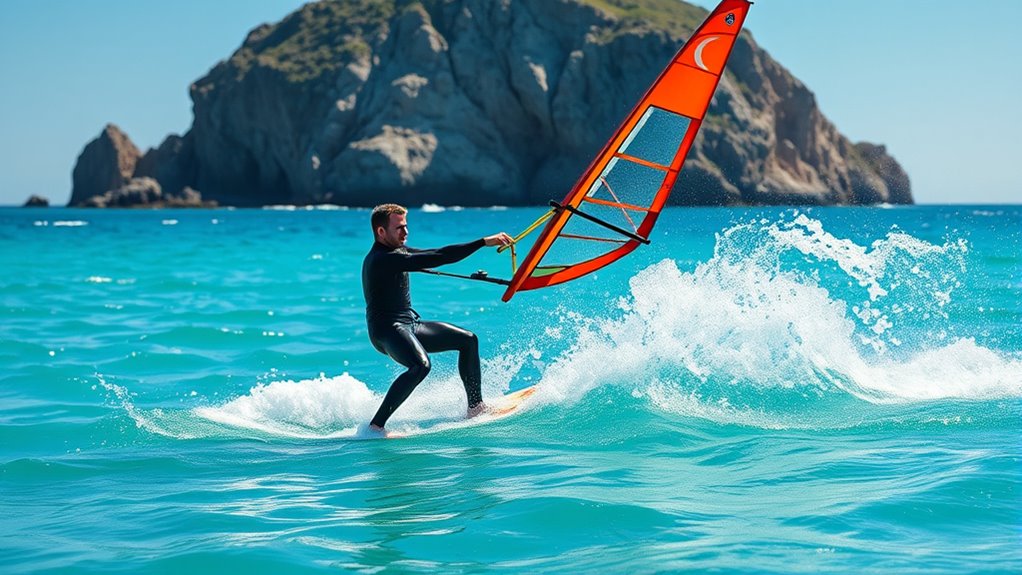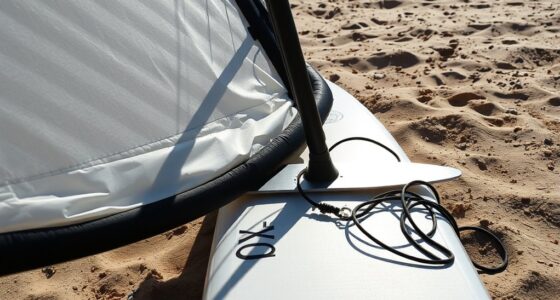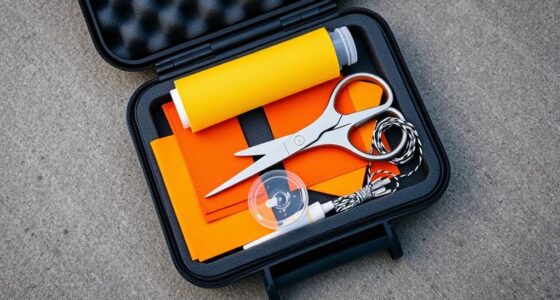Start your 7-minute wingfoil warm-up with light cardio like jumping jacks or jogging in place to raise your heart rate. Follow with shoulder rolls, trunk twists, leg swings, and walking lunges to loosen muscles and joints. Practice land-based launch simulations and steering motions to refine control and build confidence. Finish with balance drills such as standing on one leg or using a balance board to strengthen stabilizers. Keep going to discover how each step enhances your overall wingfoiling performance.
Key Takeaways
- Start with 1-2 minutes of cardio (jogging or jumping jacks) to elevate heart rate and warm muscles.
- Incorporate dynamic stretches like arm circles, trunk twists, and leg swings to mobilize joints and muscles.
- Practice land-based wing control exercises and steering motions to build muscle memory and confidence.
- Perform balance drills such as standing on one leg or using a balance board to enhance stability and coordination.
- Quickly verify gear, check weather, and ensure a safe, injury-free session within the remaining time.

Before hitting the water, a proper warm-up routine is vital to prevent injuries and enhance your wingfoiling performance. Taking a few minutes to prepare your muscles and joints can make a significant difference in how you handle your gear and maintain control during your session. A well-structured warm-up isn’t just about stretching; it’s about activating the muscles you’ll rely on and ensuring your body is ready for the dynamic movements involved in wingfoiling.
A proper warm-up activates muscles and prepares your body for safe, effective wingfoiling sessions.
Start with a brief cardiovascular activity, such as jogging in place or jumping jacks, to increase your heart rate and get blood flowing. This initial step helps warm up your entire body, making subsequent stretching more effective. Next, focus on dynamic stretches that target key muscle groups used in wingfoiling. Arm circles, shoulder rolls, and trunk twists loosen up your shoulders and back, which are vital for controlling the wing. Leg swings and walking lunges prepare your hips and legs for the balance and stance required on the board. These dynamic movements mimic the motions you’ll perform on the water, helping to improve flexibility and reduce the risk of strains.
Once your body feels warm and mobile, move on to specific techniques overview exercises aimed at improving your control and coordination. Practice quick, controlled movements with your wing on land, such as simulating water launches or steering motions. This helps you fine-tune your muscle memory and build confidence before hitting the water. Incorporate balance drills, like standing on one leg or using a balance board, to strengthen stabilizer muscles that keep you steady on the board. These exercises enhance your proprioception and reduce chances of falls or awkward landings.
While performing your warm-up, it’s important to keep safety precautions in mind. Verify your gear is properly assembled and checked for any damage. Clear the area around you to avoid accidents, and make sure the weather conditions are suitable for wingfoiling. If you’re new to the sport, consider consulting an instructor or experienced wingfoiler for personalized tips. Remember, overexertion before even starting on the water can lead to fatigue and increase injury risk, so pay attention to your body’s signals and don’t push beyond your comfort level. Incorporating crochet styles for locs into your routine can also serve as a creative outlet after your session, helping you relax and unwind from physical activity.
Incorporating these techniques into your warm-up routine guarantees you’re physically prepared and aware of safety precautions. This mindful preparation sets a solid foundation, allowing you to focus on enjoying your session while minimizing risks. A consistent warm-up not only boosts your performance but also prolongs your wingfoiling adventures by keeping you healthy and injury-free.
Frequently Asked Questions
How Long Should the Warm-Up Routine Take?
The warm-up duration should typically be around 10 to 15 minutes, giving you enough time to prepare your muscles and prevent injury. The routine length depends on your fitness level and the activity’s intensity, but a focused warm-up helps improve performance. You should include dynamic stretches, light paddling, or balance exercises to get your body ready. Keep it active and intentional, ensuring you’re fully prepared before hitting the water.
Can I Customize the Routine for Different Wind Conditions?
You can definitely customize your warm-up routine based on wind conditions. Personalization options include adjusting the intensity, duration, or specific exercises to better prepare for lighter or stronger winds. By using adaptive strategies, you guarantee your warm-up is effective and tailored to the day’s conditions. This approach helps you stay safe, improve performance, and make the most of each session, regardless of how the wind varies.
Is There Any Equipment I Should Prepare Beforehand?
Before you start your session, make sure you prepare an equipment checklist to guarantee you have everything you need. Don’t forget safety gear like a helmet, impact vest, and leash to stay protected. Check your wing, board, and pump for any damages or leaks. Having these items ready beforehand helps you warm up faster and allows you to focus on your technique, making your wingfoiling experience safer and more enjoyable.
Should Beginners Follow the Same Warm-Up as Advanced Riders?
As a beginner, you should tailor your warm-up to your skill level, focusing on basic techniques and gentle stretches. Advanced riders often incorporate advanced drills to challenge their muscles and improve performance. You shouldn’t follow the same warm-up routines; instead, start with simple stretches and gradually add more complex exercises as your skills improve. This approach helps prevent injury and builds a solid foundation for progressing in wingfoiling.
How Often Should I Update or Change My Warm-Up Routine?
You should update your warm-up routine based on your progress and any changes in your training. Typically, you might adjust the warm-up duration or routine frequency every few months or when you notice decreased performance or increased fatigue. Keep listening to your body, and if you feel you’re not getting enough benefit, it’s time to change things up to stay prepared and avoid injury.
Conclusion
Now that you’ve completed this quick 7-minute warm-up, you’re ready to hit the water feeling energized and prepared. Did you know that warming up can reduce injury risk by up to 50%? Staying consistent with this routine guarantees your muscles stay loose and your mind stays focused. So, stick to this simple plan before every session, and you’ll maximize your wingfoil experience while keeping safety a top priority. Happy riding!










